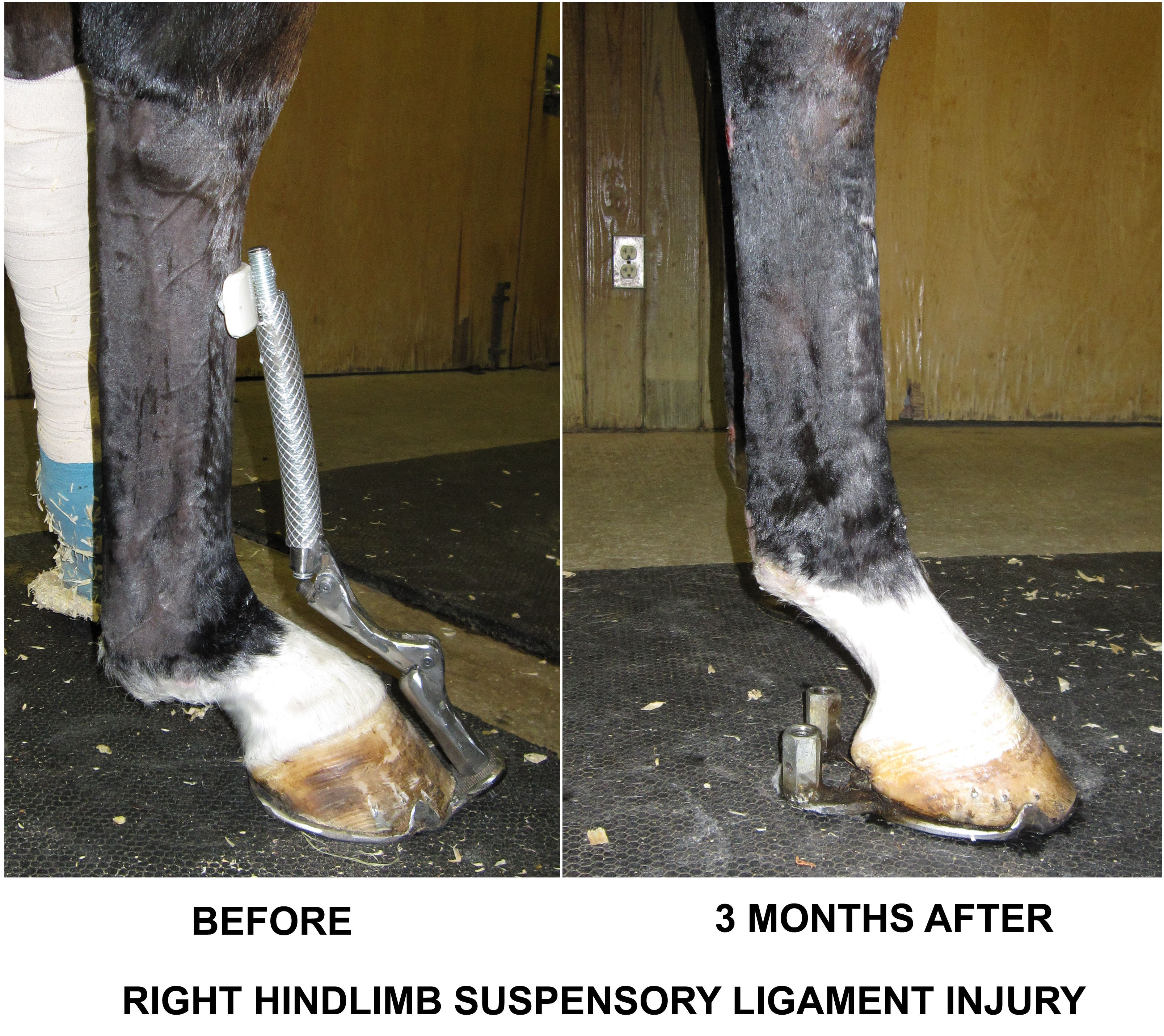Multi-level, aggressive treatments allowed equine patient to recover from debilitating lameness

Lame and in great discomfort, an 18-year old Thoroughbred gelding came to Virginia Tech's Marion duPont Scott Equine Medical Center barely able to walk.
The horse’s problem stemmed from a breakdown of both of his hind limb suspensory ligaments (the ligaments supporting the fetlock joints so they do not drop toward the ground).
The breakdown was so severe that each hind fetlock was dropped down to where it was almost parallel to the ground. Instead of a more normal 145 degrees, they were at 116 (left fetlock) and 125 degrees (right fetlock). The accompanying figure shows the right hind fetlock, pictured on the left, as the “before” image; initially, this joint was measured at 125 degrees.
“I’d say [the horse’s] condition was among the more severe that we’d seen, due to the acute nature of the problem and the severity of his pain,” noted Dr. Jennifer Barrett, assistant professor of equine surgery at Virginia Tech’s Marion duPont Scott Equine Medical Center. “When he arrived at the hospital, this horse was in a life-threatening situation. His high level of pain was a serious concern, and the degree to which his hind limbs had dropped left an open question of whether we would be able to provide a humane level of comfort for him in the long term.”
Barrett, working with other equine specialists at the center, including master farrier Paul Goodness, developed a three-pronged strategy to help the patient. First, his high level of pain was alleviated with a constant intravenous infusion of pain-relieving medications; second, his degenerating suspensory ligaments were treated with regenerative medicine techniques, namely platelet rich plasma injections; and third, his fetlock joints were supported upward to a more normal position with custom-designed shoes.
The horse received a three-dose series of platelet-rich plasma (PRP) treatments; these injections of enriched, blood-based medication directly into the injured portion of the suspensory ligaments helped stimulate and speed up the healing process.
Because hind limb suspensory ligaments typically recover poorly and have a reduced chance of complete healing, newer therapies — including surgery, PRP, and stem cell therapy — have improved the recovery chances for horses with these injuries.
“We were counting on the PRP to spur healing for [the horse], while we re-aligned the fetlocks with the custom-designed shoes. The fact that both his hind limbs were affected only made matters worse, but we didn’t give up hope,” Barrett said.
During the course of treatment with platelet rich plasma therapy, Goodness created two sets of shoes for him that would help provide the support he needed to realign his hind limbs while the ligaments healed. Supporting the fetlock joints was a key factor in the process; however, that support created pressure sores in the areas of support.
“It was a race between the healing of the ligaments and treating the sores on the skin during the time [the horse] needed support for his rear limbs,” Barrett said. “Instead of the weight of the horse being supported by ligaments, it was being supported by slinging his fetlocks from the outside with extensions from his shoes. So, his skin experienced the pressure that the ligament usually supports.
“Because of the severity of [the horse’s] condition, each of these approaches was applied more aggressively than in horses with a more moderate case of suspensory injury,” Barrett said. “We are very pleased with how rapidly and completely [the horse] responded to his treatments. When we measured his hind limb fetlock angles after three months of treatment and saw that they actually matched his normal front limb angles, we were all very happy.”
“We expect a full recovery, and plan to monitor his progress because this treatment approach may help other horses out there,” Barrett noted.
The horse’s owner is delighted with the outcome. “The way I see it,” the owner said, “is that they brought him back from the brink. My horse might not have survived this without the team at the equine medical center. At this point, whatever they tell me to do with him, I do!”




